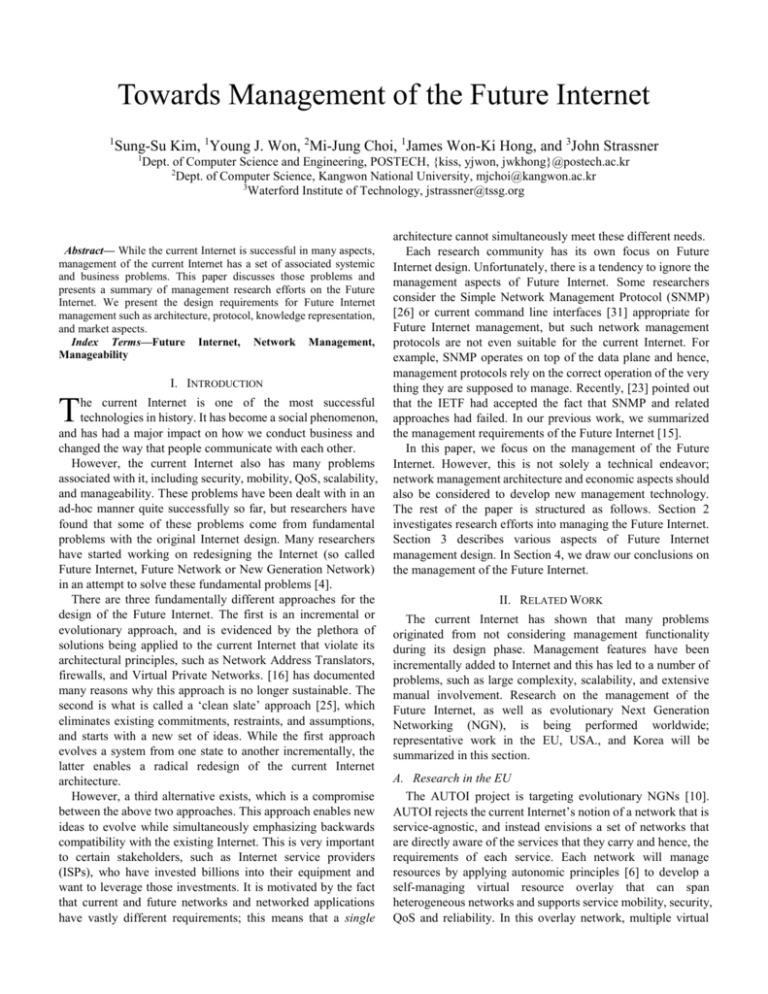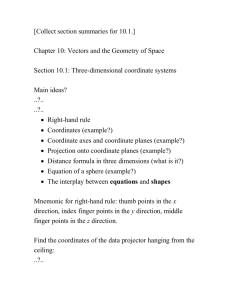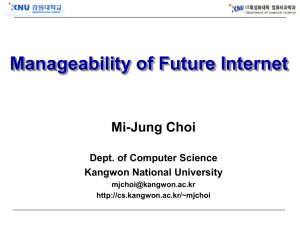Towards Management of the Future Internet 1Sung
advertisement

Towards Management of the Future Internet
1
Sung-Su Kim, 1Young J. Won, 2Mi-Jung Choi, 1James Won-Ki Hong, and 3John Strassner
1
Dept. of Computer Science and Engineering, POSTECH, {kiss, yjwon, jwkhong}@postech.ac.kr
2
Dept. of Computer Science, Kangwon National University, mjchoi@kangwon.ac.kr
3
Waterford Institute of Technology, jstrassner@tssg.org
Abstract— While the current Internet is successful in many aspects,
management of the current Internet has a set of associated systemic
and business problems. This paper discusses those problems and
presents a summary of management research efforts on the Future
Internet. We present the design requirements for Future Internet
management such as architecture, protocol, knowledge representation,
and market aspects.
Index Terms—Future Internet, Network Management,
Manageability
I. INTRODUCTION
T
he current Internet is one of the most successful
technologies in history. It has become a social phenomenon,
and has had a major impact on how we conduct business and
changed the way that people communicate with each other.
However, the current Internet also has many problems
associated with it, including security, mobility, QoS, scalability,
and manageability. These problems have been dealt with in an
ad-hoc manner quite successfully so far, but researchers have
found that some of these problems come from fundamental
problems with the original Internet design. Many researchers
have started working on redesigning the Internet (so called
Future Internet, Future Network or New Generation Network)
in an attempt to solve these fundamental problems [4].
There are three fundamentally different approaches for the
design of the Future Internet. The first is an incremental or
evolutionary approach, and is evidenced by the plethora of
solutions being applied to the current Internet that violate its
architectural principles, such as Network Address Translators,
firewalls, and Virtual Private Networks. [16] has documented
many reasons why this approach is no longer sustainable. The
second is what is called a ‘clean slate’ approach [25], which
eliminates existing commitments, restraints, and assumptions,
and starts with a new set of ideas. While the first approach
evolves a system from one state to another incrementally, the
latter enables a radical redesign of the current Internet
architecture.
However, a third alternative exists, which is a compromise
between the above two approaches. This approach enables new
ideas to evolve while simultaneously emphasizing backwards
compatibility with the existing Internet. This is very important
to certain stakeholders, such as Internet service providers
(ISPs), who have invested billions into their equipment and
want to leverage those investments. It is motivated by the fact
that current and future networks and networked applications
have vastly different requirements; this means that a single
architecture cannot simultaneously meet these different needs.
Each research community has its own focus on Future
Internet design. Unfortunately, there is a tendency to ignore the
management aspects of Future Internet. Some researchers
consider the Simple Network Management Protocol (SNMP)
[26] or current command line interfaces [31] appropriate for
Future Internet management, but such network management
protocols are not even suitable for the current Internet. For
example, SNMP operates on top of the data plane and hence,
management protocols rely on the correct operation of the very
thing they are supposed to manage. Recently, [23] pointed out
that the IETF had accepted the fact that SNMP and related
approaches had failed. In our previous work, we summarized
the management requirements of the Future Internet [15].
In this paper, we focus on the management of the Future
Internet. However, this is not solely a technical endeavor;
network management architecture and economic aspects should
also be considered to develop new management technology.
The rest of the paper is structured as follows. Section 2
investigates research efforts into managing the Future Internet.
Section 3 describes various aspects of Future Internet
management design. In Section 4, we draw our conclusions on
the management of the Future Internet.
II. RELATED WORK
The current Internet has shown that many problems
originated from not considering management functionality
during its design phase. Management features have been
incrementally added to Internet and this has led to a number of
problems, such as large complexity, scalability, and extensive
manual involvement. Research on the management of the
Future Internet, as well as evolutionary Next Generation
Networking (NGN), is being performed worldwide;
representative work in the EU, USA., and Korea will be
summarized in this section.
A. Research in the EU
The AUTOI project is targeting evolutionary NGNs [10].
AUTOI rejects the current Internet’s notion of a network that is
service-agnostic, and instead envisions a set of networks that
are directly aware of the services that they carry and hence, the
requirements of each service. Each network will manage
resources by applying autonomic principles [6] to develop a
self-managing virtual resource overlay that can span
heterogeneous networks and supports service mobility, security,
QoS and reliability. In this overlay network, multiple virtual
networks co-exist on top of a shared substrate with uniform
control. The overlay will be self-managed based on the
system’s business goals, which drive the service specifications
and implementations. AUTOI uses principles from the
FOCALE [6, 11] architecture, which is a context-aware,
policy-based autonomic architecture; this enables the services
and resources that it offers to be dynamically adjusted
according to changes in context. The AUTOI architecture is
based on the concept of planes [10].
The goal of 4WARD project is to design and test a family of
future global telecommunications networks (the 4WARD
framework) that has the potential to supersede both current
telecommunications networks as well as the current Internet
[12]. Requirements from the main non-technical perspectives
(usage and services, especially in an “Internet of
[interconnected] Things”), socio-economics, regulation,
governance, and policy) are used to derive the technical
requirements of the 4WARD framework as well as its vertical
technical themes (mobility, security, scalability, availability,
QoS, inter-provider issues, and physical layer awareness).
Special consideration is given to usability, sustainability, and
environmental awareness. Note that 4WARD is not specifically
chartered to address the design of “the” Future Internet; rather,
it is viewed that such a design will emerge from considering
other Future Networks that it must interact with. Traditional
networks are managed by an external process; in contrast,
4WARD proposes a new paradigm for network management,
where management functions come as embedded capabilities of
the devices. With this approach, network elements have
embedded management capabilities, consisting of several
autonomous components which interact with each other in the
same device and with other components in neighboring devices,
enabling these network elements to form a thin “management
plane” embedded in the network itself. This is different than the
management approach of AUTOI, whose management and
orchestrations planes are external to the devices.
ANA [13], like AUTOI, is focused on evolutionary NGNs.
ANA first focuses on the so-called “waist” of the Internet: its IP
layer. Variability in the current Internet occurs both above and
below the IP layer, giving rise to the “hourglass” model. This is
a fundamental reason why updating, let alone changing, the
current Internet is so difficult. ANA thus focuses on disruptive
technologies that “grow” a new architecture in two sets of
design-prototype-test phases. ANA is not a “one size fits all”
architecture, but rather a framework to host, interconnect, and
federate multiple heterogeneous networks (which is why it is
not a true clean-slate approach). This is done by using the ANA
framework to specify how networks interact using a set of core
abstractions.
B. Research in the USA
The FIND initiative [17] is supporting many research
projects in the design of the Future Internet. FIND has two
projects specifically related to the management of the Future
Internet. The first project, Towards Complexity-Oblivious
Network Management [14], proposes a new network
management architecture based on an approach called
Complexity-Oblivious Network Management (CONMan) [27].
In this architecture, the management plane is independent of the
data plane. Management operations, which are carried out by
software ‘network managers’ located on distributed network
devices, use the generic management interface to configure and
connect software modules on managed devices. This restricts
the operational complexity of protocols to their implementation
and allows the management plane to achieve high-level policies
in a structured fashion. Policies themselves, defined and written
by network administrators, are specified in a high-level,
declarative, domain-specific language. This language specifies
the general properties that are to be achieved and maintained;
the translation from goal specification to actual implementation
is performed by the software network managers. CONMan
technologies will support other research efforts, such as
Emulab and GENI.
The second project, “Design for Manageability in the Next
Generation Internet (NGI)” [18], is focused on reliability and
performance in the Future Internet. It assumes that most
management functions will be automated and will rely on
embedded capabilities in the network. Research is focused on
exploring design alternatives for network management building
blocks that will provide essential low-level functionality and
can then be composed in different configurations to support
management functionality. Results will include design
documentation and in some cases, initial prototypes for various
building blocks. The project also includes education and
outreach activities that will develop course materials on
network measurement, configuration and management.
The goal of the Operations, Management, Integration, and
Security (OMIS) working group [20] is to specify requirements
for operating GENI and managing its services both from a
researcher’s viewpoint and from that of its operators. They
have already described the high-level functions required for
coordinating operations in the near-term research and prototype
environment and they will propose a long-term operations
framework and define concepts of operations, including
operations management.
C. Research in Korea
The Collect, Analyze, and Share for Future Internet (CASFI)
[19] started in Korea in 2007 as an independent research group
and was successful in soliciting a project funded by the Korean
government for four years starting from March 2008. The
authors of this paper from Korea are also members of the
CASFI project. The current Internet carries many types of
traffic, such as VoIP and IPTV, not originally envisioned at its
inception, and offers many challenges in network performance
monitoring and management. CASFI intends to develop sound
and practical techniques and methods for performance
measurement and analysis of the current Internet, and gain
insight for better manageability in the Future Internet [24].
III. DESIGN REQUIREMENTS FOR FUTURE INTERNET
MANAGEMENT
A. Information exchange between management layers
The concept of layers is almost always used to build
networks. Layers can be used as a powerful abstraction
mechanism in software engineering, making complex problems
much simpler to analyze, design and implement. In addition,
layers have been used in the design of the current Internet. So, it
sounds reasonable to use layers in Future Internet management
architecture. However, management architectures need a richer,
more flexible approach, since their goal is to integrate and
harmonize data. This is especially true of autonomic
management systems, which rely on semantic reasoning to
make decisions. In other words, semantic reasoning infers
logical consequences from a set of facts or axioms. As such,
this is a search for meaning, and the fact that a fact or inference
relates to a layer is irrelevant [2]. Thus, if the layer abstraction
does not work, a new abstraction should be used. An alternative
architecture that does not use layers is FOCALE, which is
presented in Fig 1.
Orchestration
Context Manager
Control
Policy Manager
Policies control application of intelligence
Autonomic Manager
Control
Control
Control
Control
YES
Model-Based
Translation
Managed
Resource
Analyze Data
and Events
Determine
Actual State
Current State =
Desired State?
NO
Ontological
Comparison
Reasoning and
Learning
Define New Device
Configuration(s)
Control
Virtualization
and Data
Management
Fig.
FOCALE-based Version
Version of
of AUTOI
AUTOI Architecture
Architecture
Fig. 21 FOCALE-based
The basic FOCALE architecture has not changed [11],
because providing virtualization, management, and
orchestration is already done without layers. FOCALE is a
model-driven approach [28], and is based on the DEN-ng
information model [29]. DEN-ng models management and
orchestration, and FOCALE uses these models to orchestrate
behavior using the above control loops. In addition, a virtual
resource and a virtual service are already defined as managed
entities, and virtual (as well as concrete) services are already
defined as being hosted by virtual (and/or physical) resources.
Hence, the managed resource could be a physical, virtual, or
hybrid (e.g., a physical resource with virtual device or service
support) managed entity.
Therefore, as we reviewed above cases, we can also manage
the Future Internet without layers by using new architectures
such as AUTOI and FOCALE.
B. New Protocol and Addressing Approaches
Current Internet addressing has several problems, such as
routing scalability, mobility and multi-homing support. Better
addressing approaches are required for the Future Internet.
The Public Switched Telephone Network (PSTN) network
addressing separates users from the actual switching address.
Therefore, the addressing scheme insulates the switching
infrastructure from problems generated by users such as
congestion and hacking. In contrast, the current Internet uses
global IP addresses, which takes both identifier and locator
roles. To reduce problems caused by this integrated addressing
scheme, we need at least two or three separate address spaces.
An identifier has a role of making every object which has an
identifier independent of topology and physical location. An
identifier should provide the high-level functionality which will
make the Future Internet extensible and useful for such things
as access control, QoS provisioning, mobility and
multi-homing support, dissemination, and content/service
discovery. A locator should focus on fast and reliable
transmission [1].
C. Separation of Data, Control, Management, and
Inferencing Planes
In current data networks, the functionality that controls the
network is divided into three main planes: the data plane that
processes packets on a communications processor; the control
plane that routes traffic on an application processor; and the
management plane that monitors the network and configures
the data-plane mechanisms and control-plane protocols. The
original IP control plane was designed to be simple; the data
plane is maintained by a single distributed algorithm. In
contrast, the current data, control, and management plane is
more complex than this original design concept, due to the
proliferation of services that did not even exist when the
Internet was first conceived. These new services have created
many dependencies between the data and control planes, which
are usually not automatically maintained [7].
The problem is that packet delivery cannot begin until the
routing protocols create the necessary forwarding tables, and
the management plane cannot reach the control plane until the
routing protocols are configured. In most cases, to resolve this
contradiction, configuration information must be installed on
IP routers before the service can be deployed. This solution
might require hundreds of thousands of lines of low-level
configuration commands distributed across all relevant network
devices. The result is a complex and failure-prone network.
The current state-of-the-art is focused on two things:
optimizing the data plane (the data traffic represented as a path
through the network) and applying mechanisms of the control
plane (a set of discrete nodes that affect overall metrics (e.g.,
QoS) of the data traffic) as needed (but usually, on a
point-by-point solution basis, especially since the current
Internet is made up of heterogeneous devices having different
functionality and no common programming language). The
problem with this is that manageability is an afterthought,
making it impossible to configure network services and
resources to support the realization of business objectives,
particularly across heterogeneous networks with different
ownership and possibly conflicting objectives. Furthermore,
different control plane mechanisms are used that cannot be
easily coordinated.
[21] shows a conceptual overview of the inference plane to
solve these and other problems. In reality, it consists of two
separate planes, a management plane and the actual inference
plane. The concept of “Control Plane” and “Management Plane”
has been fundamental to the telecommunication model. The
control plane focuses on real-time signaling among network
elements for service provisioning and traffic engineering, and
implements distributed algorithms (e.g., routing) to enable data
plane functionality. The management plane is a near-real-time
approach for managing the network through appropriate
external interfaces that the network devices provide. It is
responsible for both configuring data plane mechanisms (e.g.,
addresses) as well as control plane protocols (e.g., routing
policies). The inference plane separates this hidden
dependency between the control and management planes in
order to create independent, scalable governance functionality.
The inference plane is a coordinated set of intelligent
decision-making components that represent the capabilities of
the computing elements being controlled, the constraints placed
upon (e.g., by regulatory and business policies [8]), and the
context in which they are being used. Most importantly, it
separates data, control, and management, enabling a better
understanding of the overall environment to be constructed.
This enables the services and resources supplied by
heterogeneous networks to be assigned and driven by business
goals and rules.
D. Monitoring and Measurement
Measuring and studying structure, performance and
unacceptable behaviors of the Internet have received increased
attention, as the Internet has evolved rapidly in the last decade.
Measuring and understanding the Internet’s properties is
necessary to troubleshoot and debug failures faster and more
efficiently, design future protocols that are better adapted to its
special characteristics, monitor performance and react
appropriately to change in real-time [9].
Measuring traffic in the current Internet is a daunting task,
especially with an ever-increasing number of connecting nodes.
Growth in the number of applications has also resulted in very
complex traffic and usage dynamics. In the Future Internet,
monitoring and measurement will be much more important,
because management requirements will increase due to a larger
number of different services being deployed. Management of
the current Internet is concentrated on monitoring and
measuring performance of network devices, not services or
users. But, in order to provide various network services in the
Future Internet, management of higher level objects (e.g.,
services and Service Level Agreements (SLAs)) instead of
current lower level objects (e.g., device interfaces) is required.
Managing services is becoming more and more complex and
time consuming for service providers, since services are
increasing both in number, complexity, and the number of users
per service. This has created a desire to enable users to partly
monitor and manage services of the Future Internet. This is
called Customer-centric Service Management (CSM). The
SLA plays a key role in CSM, as it can determine in detail the
possible user service management actions.
E. Knowledge Representation and Reasoning
Currently, there are several integrated network management
models using different technologies for resource management,
such as SNMP (Simple Network Management Protocol), CMIP
(Common Management Information Protocol), MIP
(Management Information Format) and WBEM (Web Based
Enterprise Management) [3].
Every integrated management model needs a specific
management information definition language to describe the
resources to be managed (its management domain), in order to
communicate between managers and agents. Therefore, each
model has defined its own management information definition
language which has different capabilities and expressiveness:
- SMI (Structure of Management Information), with its
different versions, for SNMP.
- GDMO (Guidelines for the Definition of Managed
objects) for CMIP
- MIP (Management Information Format) for DMI
- MOF/CIM (Managed
Object Format/Common
Information Model) for WBEM
- IDL (Interface Definition Language) for CORBA.
Problems arise when different management models are used
on the same networked system. Interoperability is necessary for
the management models to provide a unified view of the whole
managed system. However, this cannot be easily provided due
to differences in syntax and semantics. The state of the art is to
translate syntaxes; this means that when the same resource is
described with two different management information
definition languages, it is possible to apply a direct translation
between the defined structures of the descriptions, but not
between their meanings. Thus, in order to use different models,
semantic interoperability is necessary. Unfortunately, all of the
listed approaches are incapable of defining semantics, since
they are not formal languages and thus do not support reasoning
(using, for example, first order logic).
Interoperability of network management is not the only
problem; there is the problem of knowledge representation and
reasoning. SMI was built to define low-level concepts of
network devices, such as a device interface. This is true of the
other approaches as well. None provide the ability to
understand management concepts, such as how to represent
whether an SLA was violated or not. It is too difficult to
modify existing approaches; therefore, we believe that a new
approach must be created that can leverage existing low-level
concepts and employ them in management scenarios.
Another problem is provability. Assume that a problem is
found with a traffic scheduling algorithm on a certain router. It
is not good enough to make a guess that will (for example)
change the algorithm to a different type. We should be able to
prove mathematically what, exactly, will happen when the
algorithms and components are changed. Without management
data based on formal logic, it is impossible to prove changes
mathematically. There is an aspect of software engineering,
called theorem provers [30], that show that a conjecture is a
logical consequence of a set of statements. Our current research
combines theorem provers with models (to represent network
management facts) and ontologies (to formally define their
meaning and semantics) in order to build a formal network
management language [5].
In order to exchange and reuse common management data
among different applications, a common information model
must be used. Different applications will always use private
object models and different repositories that require different
data models. However, in order to share and reuse data, a
common set of mappings that use the same information model
to derive each data model must be used. This enables the
development of mediation software that can translate different
representations of the same data into different repositories, as
well as translate queries that take different forms because
different protocols are used by different repositories. We use
the DEN-ng model for this purpose, as it is the only model that
is inherently extensible (due to its being based on software
patterns), contains important sub-models (e.g., context,
metadata, and policy), and was built to support ontologies and
formal management approaches (e.g., based on finite state
automata).
F. Decisions using Uncertain or Incomplete Data
Often, network management data is incomplete, due to the
data being contained in multiple non-discoverable locations or
simply through transmission error. Another source of problems
is that the system may not be certain as to the reliability and/or
correctness of data. One way to solve these problems is to
convert a single correct definition of system behavior into a set
of acceptable system behaviors. Then, the manager selects one
behavior to use. The use of a formal language to describe these
behaviors is critical, since this enables their systematic
fuzzification and facilitates graded conclusions based on
probability and other mathematical concepts.
G. Managing Nodes based on System and Application Needs
The current Internet routing system is based on global IP
addresses, and traffic is transmitted by a simple ‘best effort’
principle. The current Internet does not have the concept of
differentiated traffic treatment. Large complex services or
systems of the Future Internet, such as enterprise websites or
distributed information systems, will be composed of both
interacting and independent components. To reflect system and
application needs, component based approaches should be
considered. In order to meet SLAs, many systems have used
over-provisioning [22]. A typical example is searching, which
uses extensive over-capacity to guarantee time limits on search
requests.
Since there will be more and more applications in the Future
Internet, and network resources are limited, over-provisioning
is not appropriate. Therefore, we need more efficient
management of network resources. It is hard to precisely
characterize or limit the dynamic behaviors of the composed
enterprise systems and applications. This characteristic makes
it difficult for system administrators to efficiently achieve
conformance to SLAs. System’s constituent components
should be individually monitored and managed to the extent
needed to attain desired runtime component behaviors. In order
to monitor each component by its own objective, mechanisms
to match high level goals to component level objectives should
be developed [6, 8].
H. Market Aspects
The management of the Future Internet must also consider
economic aspects.
The first aspect is reputation of management technology.
Assume that we choose SNMP as a Future Internet
management technology. This may complicate the tasks of
network administrators and Internet network operators, due to
the inherent problems of SNMP in security, complexity, speed,
and limited functionality.
The second aspect is market control and protection. Every
company wants to secure a lucrative niche market;
management technologies can be included as well. Some
companies contribute to standards because they want to keep
control over key technologies and their associated markets.
The third aspect is that currently, a sustainable market for
open management does not exist, due to the problems already
cited in this paper and in [23].
Considering these three aspects, Future Internet management
technology should prove that it can be profitable to vendors,
administrators, and other stakeholders.
I. Automation of Management Functionality
At the same time that networking technologies and
capabilities are expanding, there is an ever increasing need for
streamlining and economizing network operations. Network
management teams in the Future Internet must be able to
operate and maintain their infrastructures with the same or
fewer human resources than today’s networks [18]. The
motivation behind autonomic management is to identify those
functions that can be done without human intervention to
reduce the dependence on skilled resources for managing
devices, networks, and networked applications. Benefits
include reduction of manual errors and faster configuration,
which means faster service billing. If the autonomic network
can perform manual, time-consuming tasks (such as
configuration management) on behalf of the network
administrator, then that will free up the system and the
administrator to work together to perform higher-level
cognitive functions, such as planning and optimization of the
network. This holism is fundamental to solving
system-of-systems problems [24].
IV. CONCLUSION AND FUTURE WORK
We have summarized the state of worldwide research in the
management of the Future Internet and evolutionary NGNs.
Representative research was presented from the EU, USA, and
Korea. We discussed design aspects of the management of the
Future Internet, including management layers, new protocols
and addressing approaches, monitoring and measurement, the
separation of data, control, and management planes, knowledge
representation and reasoning, and market aspects. We found
that there are more complex requirements for the Future
Internet management compared to the current Internet.
Our future work will focus on developing management
information modeling, which will formalize the nature of data
and semantics.
ACKNOWLEDGMENTS
This work was partly supported by the IT R&D program of
MKE/IITA (A1100-0801-2758, “CASFI : High-Precision
Measurement and Analysis Research”] and by WCU (World
Class University) program through the Korea Science and
Engineering Foundation funded by the Ministry of Education,
Science and Technology (Project No. R31-2008-000-10100-0).
[15]
[16]
REFERENCES
[1]
[2]
[3]
[4]
[5]
[6]
[7]
[8]
[9]
[10]
[11]
[12]
[13]
[14]
J. Choi, C. Park, H. Jung, T. Kwon, and Y. Choi,
“Addressing in Future Internet: Problems, Issues, and
Approaches,” 3rd International Conference on Future
Internet Technologies, June 2008.
J. Strassner, S. van der Meer, and James W. Hong,
“Autonomic
Management
of
Communications
Networks without Using the ‘L’ Word,” submitted to
JSAC, 2008.
D. Clark, C. Partridge, J. C. Ramming, and J. T.
Wroclawski, “A knowledge plane for the internet,” In
Proceedings of the 2003 Conference on Applications,
Technologies, Architectures, and Protocols For
Computer Communications (Karlsruhe, Germany,
August 25 - 29, 2003). SIGCOMM ‘03. ACM, New
York, NY, 3-10.
T. Roscoe, “The end of internet architecture”,
Proceedings of the 5th Workshop on Hot Topics in
Networking (HotNets-V), Irvine, CA, USA, November
2006.
J. Vergara, V. A. Villagra, J. I. Asensio, and J. Berrocal,
“Ontologies:
Giving
Semantics
to
Network
Management Models”, IEEE Network, special issue on
Network Management, Vol. 17, No. 3, May/June 2003.
J. Strassner, “Autonomic Networking: Theory and
Practice”, Tutorial, 2008 IEEE Network Operations and
Management Symposium, April 2008.
A. Greenberg, G. Hjalmtysson, D. A. Maltz, A. Myers, J.
Rexford, G. Xie, H. Yan, J. Zhan, and H. Zhang, “A
Clean Slate 4D Approach to Network Control and
Management”,
ACM
SIGCOMM
Computer
Communication Review. 35(5). October, 2005.
J. Strassner, “DEN-ng: achieving business-driven
network management”, Network Operations and
Management Symposium, 2002. NOMS 2002.
IEEE/IFIP , pp. 753-766, 2002.
T. Spyropoulos, S. Fdida, and S. Kirkpatrick, “Future
Internet: Fundamentals and Measurement”, ACM
SIGCOMM Communication Review, volume 37, April
2007.
Autonomic Internet (AutoI), http://ist-autoi.eu/autoi/.
J. Strassner, N. Agoulmine, and E. Lehtihet, “FOCALE
– A Novel Autonomic Networking Architecture”,
ITSSA Journal, Vol. 3, No. 1, May 2007, pp 64-79.
4Ward, http://www.4ward-project.eu/.
Autonomic
Network
Architecture
(ANA),
http://www.ana-project.org/.
F. Paul and L. Jay, “Towards Complexity-Oblivious
Network
Management”,
FIND
project,
http://www.nets-find.net/Funded/TowardsComplexity.p
hp.
[17]
[18]
[19]
[20]
[21]
[22]
[23]
[24]
[25]
[26]
[27]
[28]
[29]
[30]
[31]
Sung-Su Kim, Mi-Jung Choi, and James W. Hong,
“Management requirements and operations of Future
Internet”, 11th Asia-Pacific Network Operations and
Management Symposium (APNOMS 2008), LNCS
5297, Beijing, China, October 2008, pp. 156-166.
D. Clark, K. Sollins, J. Wroclawski, D. Katabi, J. Kulik,
X. Yang, R. Braden, T. Faber, A. Falk, V. Pingali, M.
Handley, and N. Chiappa, “NewArch: Future
Generation Internet Architecture”, NewArch Final
Technical Report, http://www.isi.edu/newarch/.
Future
Internet
Network
Design
(FIND),
http://find.isi.edu.
B. Paul, B Suman, and E. Cristian, “Design for
Manageability in the Next Generation Internet,” FIND
project,
http://www.nets-find.net/Funded/Manageability.php.
Collect, Analyze, and Share for Future Internet (CASFI),
http://casfi.kaist.ac.kr/.
Global Environment for Network Innovations (GENI),
http://www.geni.net/wg/omis-wg.html.
J. Strassner, M. Foghlú, W. Donnelly, and N.
Agoulmine, “Beyond the Knowledge Plane: An
Inference Plane to Support the Next Generation
Internet”, IEEE Global Information Infrastructure
Symposium (GIIS 2007), 2-6 July, 2007, pages
112-119.
V. Kumar, K. Schwan, S. Iyer, Y. Chen, and A. Sahai,
“A state-space approach to SLA based management”,
IEEE Network Operations and Management
Symposium (NOMS 2008), April 2008, pp.192-199.
J. Schonwalder, A. Pras, and J.-P. Martin-Flatin, “On
the future of Internet management technologies”, IEEE
Communications Magazine, vol.41, no.10, pp. 90-97,
October 2003.
Mi-Jung Choi, Sung-Su Kim, James W. Hong, and J.
Strassner, “Towards the Future Internet and Its
Manageability”, Submitted to IEEE Communications
Magazine, October 2008.
N. McKeown and B. Girod, “Clean slate design for the
internet.” Whitepaper; Information available at:
http://cleanslate.stanford.edu/, April 2006.
D. Harrington, R. Preshun, and B. Wijnen, “An
Architecture for Describing Simple Network
Management Protocol Management Frameworks”,
RFC3411, STD0062, December 2002.
H. Ballani and P. Francis, “CONMan: A Step Towards
Network Manageability”, ACM SIGCOMM Computer
Communication Review, Vol. 37, Issue 4, October 2007,
pp. 205-216.
www.omg.org/mda.
J. Strassner, “DEN-ng Model Overview”, Joint ACF,
EMANICS, and AutoI Workshop on Autonomic
Management in the Future Internet, May 14, 2008.
M. Fitting, “First Order Logic and Automated Theorem
Proving”, Springer-Verlag, second edition, 1996, ISBN
0387945938.
http://www.cisco.com/warp/cpropub/45/tutorial.htm,
accessed February 6, 2009, from this URL.










